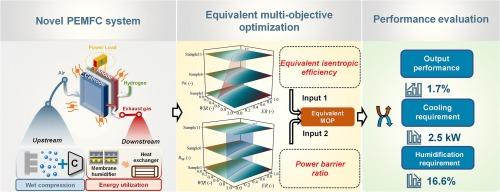Performance improvement of high-power PEMFC using wet compression and exhaust energy multiple utilizations
IF 9.9
1区 工程技术
Q1 ENERGY & FUELS
引用次数: 0
Abstract
To improve the efficiency of the high-power proton exchange membrane fuel cell (PEMFC) system, a novel system integrated with wet compression and cathode exhaust energy recovery is proposed. A 1D steady-state model is established for the proposed system to obtain the thermodynamic operating modes. The NSGA Ⅱ algorithm is used to identify the suitable humidification strategy for each operating point. The results show that the utilization of wet compression for the PEMFC system has multiple combined benefits. Considering the available gains in the practical wet compression process, the trade-off in compression efficiency at the rated point results in an increment of 3.6 %. The parasitic power of the compressor decreases from 15.3 kW to 12.1 kW. The electrical efficiency and the net output power of the proposed system increase by 1.7 % and 8.0 kW, respectively. Furthermore, parametric analysis of wet compression reveals additional advantages in precooling and external humidification processes. At the rated point with the wet compression, the heat load of the liquid cooling heat exchanger decreases from 6.6 kW to 4.1 kW, and the water recovery ratio of the membrane humidifier reaches 30 %. The findings of the novel PEMFC system provide substantial guidelines for treating cathode exhaust gas and for the development and utilization of wet compression in fuel cell systems.

利用湿式压缩和废气能量多重利用提高大功率 PEMFC 的性能
为了提高大功率质子交换膜燃料电池(PEMFC)系统的效率,提出了一种集成了湿式压缩和阴极废气能量回收的新型系统。为获得该系统的热力学运行模式,建立了一维稳态模型。采用 NSGA Ⅱ 算法为每个工作点确定合适的加湿策略。结果表明,在 PEMFC 系统中使用湿压缩技术具有多种综合优势。考虑到实际湿式压缩过程中的可用增益,额定点压缩效率的折衷结果是增加了 3.6%。压缩机的寄生功率从 15.3 千瓦降至 12.1 千瓦。拟议系统的电气效率和净输出功率分别增加了 1.7 % 和 8.0 千瓦。此外,湿式压缩的参数分析显示了预冷和外部加湿过程的额外优势。在湿式压缩的额定点,液体冷却热交换器的热负荷从 6.6 kW 降至 4.1 kW,膜加湿器的水回收率达到 30%。新型 PEMFC 系统的研究结果为处理阴极废气以及在燃料电池系统中开发和利用湿式压缩提供了重要指导。
本文章由计算机程序翻译,如有差异,请以英文原文为准。
求助全文
约1分钟内获得全文
求助全文
来源期刊

Energy Conversion and Management
工程技术-力学
CiteScore
19.00
自引率
11.50%
发文量
1304
审稿时长
17 days
期刊介绍:
The journal Energy Conversion and Management provides a forum for publishing original contributions and comprehensive technical review articles of interdisciplinary and original research on all important energy topics.
The topics considered include energy generation, utilization, conversion, storage, transmission, conservation, management and sustainability. These topics typically involve various types of energy such as mechanical, thermal, nuclear, chemical, electromagnetic, magnetic and electric. These energy types cover all known energy resources, including renewable resources (e.g., solar, bio, hydro, wind, geothermal and ocean energy), fossil fuels and nuclear resources.
 求助内容:
求助内容: 应助结果提醒方式:
应助结果提醒方式:


